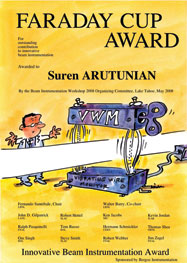 |
|
Image courtesy of Pierpaolo Pugnali |
Pécub's Cup
A Faraday Cup is (pick one) 1) a gadget named after the great experimentalist Michael Faraday, used to measure the current of a charged-particle beam, or 2) an award that recognizes the inventors of innovative instruments for particle accelerators.
Trick question. It's both. This year the Faraday Cup, awarded biannually since 1992, was presented on the opening day of the 2008 Beam Instrumentation Workshop, sponsored by Lawrence Berkeley National Laboratory and held at Lake Tahoe in early May. In keeping with the workshop's theme—the challenges of beam diagnostics—Suren Arutunian, head of the Low Temperature Physics Laboratory at Armenia's Yerevan Physics Institute, won the award for inventing a beam-diagnostic "vibrating wire scanner" for the Yerevan Synchrotron.
Second trick: the Faraday Cup Award isn't a cup at all. It's a work of art. In 1981 the Italian Swiss artist Pierpaolo Pugnali, better known as Pécub ("P cubed"), illustrated some ads in the CERN Courier for a new company, Bergoz Instrumentation. Pécub and the company's founder, Julien Bergoz, became friends, and in 1992 Bergoz asked him to design the certificate for a new award his company was sponsoring. Voilá.
"You can't tell Pécub what he should draw," says Bergoz. "You tell him what you want to communicate; he listens intently, then draws four or five sketches on a large sheet of paper— less than two minutes per sketch." Once a sketch is chosen, "he gets his set of seven or eight small pots of colored ink, dips his fingers in a few... Another four minutes and it's done."
Bergoz thinks of Pécub as both an artist and a philosopher of science: "I am always amazed how he can imagine things I have not told him." It was Bergoz who introduced Pécub, who has a scientific background in pharmaceutical research, to high-energy physics.
Says Pécub, "The invisible in biology and the invisible of basic matter are closely connected. Bridges to put imagination into the big bang... Your atomic world is so infinite in questions."
Although there's no poster this year, Pécub has drawn a handsome certificate for the winner.
Paul Preuss, Berkeley Lab
Click here to download the pdf version of this article.






